Leonore was built in 1966 so this year is her 50th birthday year and I thought a special cruise was befitting. This thought was augmented by two factors: First towards the end of last year my friend and ex-neighbour Phil, being fed up with not managing to organise a cruise on his boat booked a place with me for 2016 like in the old days before he bought a boat - I snapped his hand off! Then at Christmas my friend Mick apologised for not coming in 2015 and promised to come this year, but tragically a few days later he was suddenly taken ill and died. Goes to show you can't tell what's round the corner and you should get on and do stuff while you can. Although it would be difficult on her, Christine was brilliant and fully supported me.
Phil and I toyed with joining the Classic Malts Cruise but in the end decided doing our own was better - after all seen one distillery you've seen ‘em all! I sketched a three week cruise basically one week up to Scotland, one up there and another back. A natural crew to make up the three with Phil was Jon as we had had many cruises in the past, so that was the middle week sorted. Once the idea was floated several others expressed interest and I put Andy Cunningham and Tim Davies together for the first week and David Hammond and Howard Williams on the third. A slight hitch occurred late on as Andy was unable to start till halfway through but luckily Paul Sanders stood in for that time.
11-12 June Pembroke Dock – Greystones (Dublin)
So all the prep work is done and finally three of us assemble at Hobbs Point to enact the great plan. Myself, Tim and Paul embarked at just before high tide to get a push downhaven and up to Skomer in the forecasted very light SSW wind. Actually and thankfully there was a bit of wind and we made adequate if gentle progress without engine. Rounding Skomer we made off for the Arklow Bank South end, passing close to The South Bishop lighthouse. The wind was never very much and moved to more southerly forcing us to tack downwind as there was a sizeable swell making a spinnaker run uncomfortable. By nightfall we were some 40 miles from the Arklow Bank and is a relatively safe area for traffic, and indeed there was very little. Dawn broke with still 20 miles to our first waypoint, and still tacking downwind, and thus it was early afternoon when we passed about 10 miles east of the 20 mile long Arklow Bank which is home to a striking line of massive wind turbines and guarded by the world’s biggest North Cardinal at its northern end. I don’t think they want anybody to miss it! At this point we’re actually north of Wicklow and Dublin is within striking distance. However, our poor progress had run us into a strong southbound anti tide and we would really struggle to get past Dalkey Island into Dublin Bay, so after a quick consultation of our library it looked like the new marina at Greystones was a possibility, and sure enough VHF contact resulted in a very friendly invite – the only problem was finding it along the grey coast. GPS to the rescue although we still weren’t sure where to enter till about 100m away! A brand new set-up greeted us with temporary facilities which were very welcome. We were in plenty time for a leisurely pint and stroll into town to choose our eatery, having forsaken the option of getting a train into Dublin to maximise the relaxation after our long journey.
13 June Greystones – Port Oriel
Next morning allowed a lie in waiting for the tide, however we were awoken by the steady clanging of a piledriver as the marina/residential complex continued to be constructed. Light rain accompanied our exit northwards in the tide up to Dalkey Sound and by the time we got into Dublin Bay visibility had dropped to a dangerous level given the traffic in the bay. We managed to cross the bay safely thanks to AIS which pinpointed the unseen traffic including 33 knot ferries and half a dozen anchored ships. Going north of Howth the viz improved and we had a decent sail, initially tacking downwind and deciding to go outside Lambay Island and pass close to the interesting Rockabill outcrop. We then had a go at running up the coast under spinnaker which was ok for a while as we again searched the books for options for the night, and eventually decided on Port Oriel although it didn’t seem to have much to offer it was in the right place. This time the GPS was not so wonderful, as its plot showed us passing over a concrete pier as we made the visually obvious approach to the fishing port. We pulled up to a wall to ask for mooring and were told we’d be ok right there so that was that and we got ready for a walk to civilisation at Clogherhead some 2 miles away. A meal was forthcoming, followed by a quaint but friendly pub session with very dubious local singing and an interesting RNLI museum curator who invited us to visit tomorrow. Replete, we ambled home to our working fishing port, noting that the inner harbour had dried completely.
14 June Port Oriel – Ardglass
In the morning a moderate northeasterly was established in mist and seeing as our destination (Ardglass) was north east we decided regrettably there wasn’t time to visit the RNLI museum so we set off after breakfast along the coast under the Mountains of Mourne.
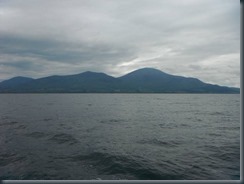
A day’s tacking was virtually all heroically helmed by Paul as we passed the entrance to Carlingford, Kilkeel and Annalong eventually getting in a bit of a reach approaching Ardglass as the weather turned sunny! Coming in to a free berth in the marina we were met by Andy who had come down from Belfast and was well at home on a neighbouring boat that even offered him a bunk for the night as we were a bit crowded.
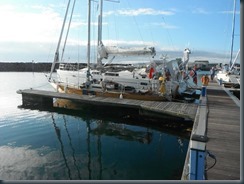
Off we went to the Golf Club for a couple of drinks before ending up in the Chinese restaurant.
15 June Ardglass – Carrickfergus
In the morning we said cheerio to Paul as he set off home by bus and ferry. It was a lovely day, especially welcomed after yesterday and began with a good breeze albeit putting us closehauled. However, as the sun shone stronger, the wind fizzled out and we continued on tide and engine, as we really had to make Copeland Island at the entrance to Belfast Lough before the turn. We managed it a bit late, at which point the wind came up and we tacked through Copeland Sound and then reached across the Lough to Carrickfergus, dodging large commercial traffic. On the way we somehow suffered the disaster of running out of tea! Had we not been close to port it would have merited a Pan-Pan, being as we were under the red ensign. Passing the famous castle we tied up in the council-run marina. Walking through town to refuel was unbearably hot in the sun, and we had to resort to Weatherspoons a bit early for refreshment.
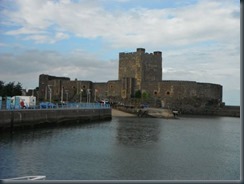
Here we hatched a plan that in view of the forecast northerlies, we could maybe reach across to the Clyde, make up to the Crinan Canal (thanks for the advice, Maelstrom) and rejoin the northbound route at the northern end of the canal...it could be done in the available days.
16 June Carrickfergus – Whiting Bay (Arran)
Northerlies it was and as soon as we nosed out of Belfast Lough it was obvious the Clyde option was favourite. We couldn’t make Campbelltown, but the southwestern tip of Arran was possible though distant on port tack. The wind came and went but towards late afternoon we passed the lump of Ailsa Craig
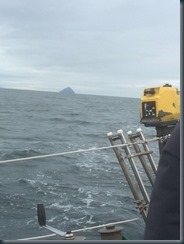
and made on for Arran but the wind failed and we ended up motoring and took the first option of mooring buoys, which was at Whiting Bay just short of Holy Island and Lamlash. Pumping up the dinghy as we approached, we tied up and rushed ashore where we were lucky to get dinner in an excellent fish and chip restaurant , before finding a suitable pub complete with quiz night.
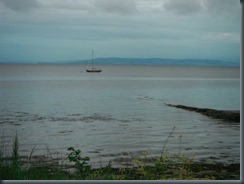
17 June Whiting Bay – East Loch Tarbert
A beautiful day greeted us and we were keen to get off and sail around Arran, starting with a reach up to the beckoning and impressive Holy Island opposite Lamlash.
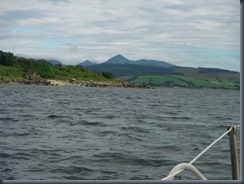
By now we were having to tack north but drinking in the spectacular views of Arran’s mountains really made it a pleasurable journey.
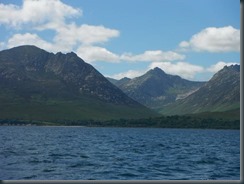
The only downside was that progress was slow and we weren’t going to make a proposed lunch stop at Lochranza and still keep schedule for the canal passage – we couldn’t complain! Continuing north against the wind we plumped for an overnight at the marina in east Loch Tarbert, provided we made an early start for the canal in the morning. Although nobody was at the layed-back marina, facilities were open and the town provided good pubs and an Indian restaurant.
18 June East Loch Tarbert – Crinan
We duly got up early..well except Andy who stayed in bed having stayed up last night to test (successfully) that he could read in the remaining light at midnight. There was no wind so we made the 8 miles on engine in glorious weather, and at Ardrishaig drove straight into the first canal lock, tied up and sorted the paperwork. A hundred and forty seven pounds lighter I reboarded and we set off accompanied by two other yachts whilst ground staff did all the hard work on the lock gates for us.
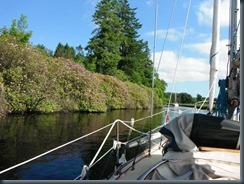
We struck up a very friendly camaraderie with Mike and Jacky on Arietta which was just as well, as after a few locks our engine complained at all the ticking over and decided to take time out with a flooded carb. Tied alongside Arietta we were actually better off as they actually had the facility of reverse gear and so were able to hurry into locks and stop whereas we were having to approach dead slow which was slowing the party down. The scenery was very pleasant and the sun shone...what a great way to travel, even if it was fresh water! After fifteen locks we arrived at the Sea lock in Crinan and our fellow travellers carried on out to sea whilst we stayed in the large welcoming lock to relax and explore.
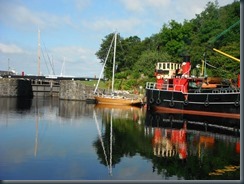
Fuel was available at a decent chandlery and later we had dinner in the hotel followed by an interesting bar session with fellow yachtsmen, where we were advised that the Oban marina we had planned was not providing a late night ferry service which we would be needing so a change to Dunstaffnage was recommended.
19 June Crinan – Dunstaffnage (Oban)
Happy birthday Andy! All very civilised we named our time with the lock staff and were duly moved out to sea, meeting a southeasterly force 4/5 with a bit of drizzle. The first of a long string of waypoints came up straight away at Dorus Mor a passage between islands that can be tricky at the wrong time of tide – no problem for us today.
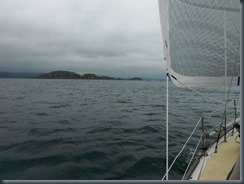
For the next passage I chose to go inside Reisa Mhic Phaidean Island next to Craignish on the mainland so as not to be exposed to the push that exists on a north tide towards the Gulf of Corryvreckan, a very dangerous area that generates a big whirlpool in bad conditions. I thought this wise as our engine had been dodgy yesterday and you never know when the wind might fail. Next passage was the Sound of Luing, big and wide with a well-marked group of rocks at the northern end, then more rocks and up to Easedale followed by the Sound of Insh between Seil and Insh Island. Some trepidation here as this is where Maelstrom ran onto a sunken reef to the north of the island, just awash today.
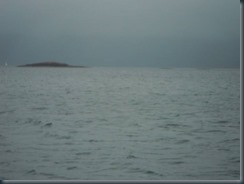
So we kept well over to the Seil side whilst conjecturing as to which of the progressively disappearing reefs it might have been. Peeking out into the main Firth of Lorn we now made our way over to Kerrera Sound which leads up to Oban.
As we reached Oban, we briefly re-assessed the various options for mooring or marina, but decided we really didn’t want to crew change by dinghy in the rain so we cruised on by, and out of the northern exit of Kerrera Sound round to Dunstaffnage. Here we met up with Andy’s wife Lin and dog Brin who had come up by campervan. It rained most of the evening as we got tidied up and sorted for crew change before getting a meal at the Widemouthed Frog, the local bar/restaurant. The new crew were having a bit of a nightmare with rain and roadworks on the way up by car, and it was touch and go as closing time approached. Eventually the phone informed us they were close and I got them a round in despite barman ‘Mr Happy’ grumping about it. So hi to Phil and Happy birthday as to well to Jon.
20 June Dunstaffnage – Tobermory (Mull)
Tide dictated that we had most of the morning off completing our crew change, beginning with a breakfast in the Frog for both crews together. A trip down the road for re-provisioning, cheerios all round and we prepared for sea at midday. Still drizzling. A WSW 4/6 wind allowed a quick ‘finish with engines’ and we made our way over to the Sound of Mull on genoa.
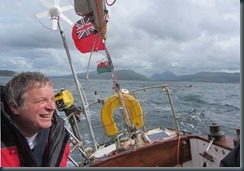
This wind was converted by geography to run directly against us down the Sound, so we short-tacked up on the tide before motoring into Tobermory as the weather improved to make a lovely late afternoon. Not fancying the small marina we took one of many available visitor buoys, which turned out to be a good move as the pontoons were plagued with midges which didn’t seem able to make the short trip out to the buoys, plus the view of the pretty harbour was better.
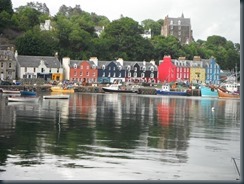
We made a poor choice of pub for dinner, but it happens! At the subsequent planning meeting the Hebrides were our oyster and we decided we would go to the outer isles on a beam reach, Barra or the Uists or even Skye whichever fitted.
21 June Tobermory – Lochboisedale (South Uist)
Up early and motoring the rest of the Sound of Mull northwards we were met by a S to SW wind force 4 and increasing. Setting a beam reach past the Point of Ardnamurchan (most westerly part of the UK mainland) we were headed to Lochboisedale, where there was reported to be a new marina. This went fine but the wind steadily increased and reefing was twice required before we could see the outer Hebrides in the poor visibility. Locating the entrance and then the inward passage to Lochboisedale was not at all obvious, but GPS helped
and welcomed by the manager who even went and got our fuel for us from the village.
![clip_image002[4] clip_image002[4]](/Data/Sites/1/media/wlw/clip_image002[4]_thumb.jpg)
New facilities were wonderful, and the nearby village had a very agreeable hotel for dinner and drinks. The scenery here was remote and somewhat desolate, maybe it was just the mist but it didn’t have the charm of Castlebay on Barra that I had previously visited.
22 June Lochboisedale – Loch Harport (Skye)
We had toyed with the idea of going up to North Uist or to Dunvegan on Skye but it would rule out some other options later given upcoming weather so we compromised on Loch Harport, home of Skye’s famous Talisker distillery. Everything looked better in the clearer skies and as we drew away from harbour we could see much more of the outer Hebridean chain including some respectably high peaks. A good wind took us comfortably to Skye where we marvelled at McLeod’s maidens, weird towers in the sea just outside the entrance to Loch Bracadale,
![clip_image004[4] clip_image004[4]](/Data/Sites/1/media/wlw/clip_image004[4]_thumb.jpg)
which further leads on to Loch Harport.
By now it was a lovely day as we nosed our way down to Carbost spectacularly backed by the Red Cuillin mountains and identified a suitable visitor buoy.
![clip_image006[4] clip_image006[4]](/Data/Sites/1/media/wlw/clip_image006[4]_thumb.jpg)
The pub ashore had an excellent gastro menu, great beer and a peaceful view of the boats out in the loch – a lovely spot.
![clip_image008[4] clip_image008[4]](/Data/Sites/1/media/wlw/clip_image008[4]_thumb.jpg)
23 June Loch Harport – Loch Slapin (Skye)
We wanted a proper ‘wild camp’ location and identified Loch Slapin as the choice nearby, so after a quick trip ashore for a shop visit we made our way out to sea and tacked eastwards in light wind – pleasant enough. Eventually we had to use engine to get along past fabulous serene views of the Black Cuillins at Loch Brittle on one side
![clip_image010[4] clip_image010[4]](/Data/Sites/1/media/wlw/clip_image010[4]_thumb.jpg)
and the high peaks of Rhum on the other.
![clip_image012[4] clip_image012[4]](/Data/Sites/1/media/wlw/clip_image012[4]_thumb.jpg)
We then passed the island of Soay famous for sheep and into Loch Slapin. Some six miles up, we had penetrated into a niche of the Red Cuillins for the night’s anchorage totally alone in fantastic surroundings. Although we had no need, we inflated the dinghy just to take pictures!
![clip_image014[4] clip_image014[4]](/Data/Sites/1/media/wlw/clip_image014[4]_thumb.jpg)
A meal on board and a couple of beers was magical.
![clip_image016[4] clip_image016[4]](/Data/Sites/1/media/wlw/clip_image016[4]_thumb.jpg)
24 June Loch Slapin – Inverie (Knoydart)
Back in civilisation, the result of the EU referendum was now known, but we could get no radio reception. Eventually my transistor on LW with its aerial held to the mast hissed weakly that Cameron had resigned and that was how it dawned on us what the result must be. On board it was two outs and an in. As we made our way down loch and towards Point of Sleat reception came in and we listened to hours of indignation from the Scottish media so we knew to be sensitive to this in the evening. Going was slow and after rounding Sleat we were on a gentle run towards Mallaig, under windvane control with the sun shining
![clip_image018[4] clip_image018[4]](/Data/Sites/1/media/wlw/clip_image018[4]_thumb.jpg)
and generally having a most agreeable time – even eliciting Phil’s famous saying ‘it doesn’t get a lot better than this’!. Passing Mallaig, avoiding Skye ferries we entered Loch Nevis
![clip_image020[4] clip_image020[4]](/Data/Sites/1/media/wlw/clip_image020[4]_thumb.jpg)
and made our way to Inverie on the loch’s north coast, taking a visitor buoy. This area is Knoydart, said to be the most remote part of Britain. Contrary to pilot book notes we had there were no facilities, save a single shower in the pub for £4 – not taken up by any of us once we had begun drinking. The pub (The Old Forge) has a great reputation for seafood which was one reason for coming here - it was pretty good, but not spectacularly so and a mite expensive, but that’s understandable given the location. Not so the bar’s tendency to serve short pints and be grumpy about topping up. However it’s a great scenic setting which put us in a mood to excuse this. We were treated to a fabulous serene sunset.
![clip_image022[4] clip_image022[4]](/Data/Sites/1/media/wlw/clip_image022[4]_thumb.jpg)
25 June Inverie – Tobermory
Next morning started with mist swirling round the mountains.
![clip_image024[4] clip_image024[4]](/Data/Sites/1/media/wlw/clip_image024[4]_thumb.jpg)
We sailed off the buoy tacking out of the loch back to Mallaig and then turning south onto an all-day starboard tack whist we contemplated a stop on Eigg or Muck for lunch or even overnight, but in the end thought we’d better use the good wind we had and pressed on to Ardnamurchan Point in the sunshine.
![clip_image026[4] clip_image026[4]](/Data/Sites/1/media/wlw/clip_image026[4]_thumb.jpg)
From here we had a run down the Sound of Mull to Tobermory and took one of their buoys again. After showering we regrouped in the first pub on the quay which turned out to be perfect for beer and then food too. Forecast for tomorrow was poor later, but tide was best later. Weather won out and we opted for an early start.
26 June Tobermory – Dunstaffnage
Sure the sun was shining, but there was precious little wind and on the nose, with tide against.
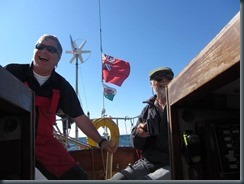
Nonetheless we set off and clawed our way down the Sound of Mull getting only one or two knots closer to target every hour. Gradually the rain came and wind got up a bit as tide slackened and by the time we made it down to Lady’s Rock at the end of Lismore Island visibility became very poor and so AIS was scrutinised in detail as various ferries and craft were close by on various headings. As we drew away from the Oban area contacts cleared away and we made it safely to Dunstaffnage in the rain..does it always rain here? We tied up on the ‘breakwater’, a massively built new pontoon with a concrete surface, but as yet no services, and so shunned by the fridge and shower minded cruisers.
26 June - 1 July – Interlude
Phil had left his car at Dunstaffnage and so we quickly cleared up, refuelled the boat and headed into a different world in a swish and snug car shielded from the rain and headed down through Scotland and to Jon’s Lakeland house next to the pub where we had secured dinner in advance (thank you landlord). Next day we dropped Jon off at Liverpool to catch his plane back to Amsterdam while Phil and I continued to Bristol, from where I got the Megabus back to Pembroke Dock for a break.
After my break Maggie drove Howard and I to Carmarthen where we started our train journey north. At Preston we joined a train that was carrying David c.oming from Milton Keynes, so crew complete! Quick bite and drink in Glasgow and last train up to Oban where I had fixed a taxi to Dunstaffnage where we were in time for dinner and drinks before stumbling aboard.
2 July Dunstaffnage – Craighouse (Jura)
A drizzly start to the day, and the southbound tide through the series of sounds ahead was not going to start till early afternoon, and so we had a concerted effort to get the Widemouthed Frog to make us breakfast and though it was hard work we were successful thanks to a bit of charm from Howard! Then we began to get things together, sending David down to the shop for initial victualling. With a west wind we were all ready to go well before the tide and decided to make what ground we could as the rain had now stopped. We made our way round the fish farms and into Oban bay which was very busy and had the new crew on their toes judging the entry around the various comings and goings of ferries large and small. Things calmed down south of Oban as we made our way down the Sound of Kererra only sharing it with a couple of big Trawlers on their way back to Ardglass. Emerging from the southern end of the sound we were again exposed to the stiff westerly and put onto
the wind by the course to the next waypoint. This required a reef in the main, and almost complete I set to winding down the clew outhaul when BANG and I was holding the winch handle with a loose winch drum
![clip_image002[6] clip_image002[6]](/Data/Sites/1/media/wlw/clip_image002[6]_thumb.jpg)
attached, the winch having pulled off the boom where it had lived! Luckily an alternative winch on the mast did a jury stint and job was a good ‘un. So now we were on to the next sound, Insh Island, whose western side holds the notorious ‘Maelstrom Rock’ today just barely underwater as we passed well clear to the east. Now we were picking up speed as the tide strengthened, and the waypoints came thick and fast: Easdale, Bogha Rocks, Fladda, an into the long sound of Luing ending with the island of Scarba and the dreaded Gulf of Corryvreckan in the short gap across to the north tip of Jura.
![clip_image004[6] clip_image004[6]](/Data/Sites/1/media/wlw/clip_image004[6]_thumb.jpg)
Here we were doing 12 knots over ground and continued doing 7 knots for most of the rest of the trip close to the coast of Jura..what a push! Nonetheless it was 8:30 as we approached Craighouse so it was a case of blowing up the dinghy and preparing for shore as we went along, to give the best chance of dinner in the pub, which was duly provided with good grace as we shambled into the Hotel in our oilies just after 9pm - phew!
![clip_image006[6] clip_image006[6]](/Data/Sites/1/media/wlw/clip_image006[6]_thumb.jpg)
3 July Craighouse – Church Bay (Rathlin Island)
Southbound tides were later on today again and so after breakfast we went ashore and looked around, principally for fuel but being Sunday everything including the Distillery was shut.
![clip_image008[6] clip_image008[6]](/Data/Sites/1/media/wlw/clip_image008[6]_thumb.jpg)
We did get a shower and a very pleasant coffee in the pub garden however. As yesterday we set off with a bit of tide-against but with a fair wind from the west, which strengthened usefully in the gap between Jura and Islay, whose coast we now followed down to the open sea between Scotland and Northern Ireland, with Rathlin Island being our target. A cross tide put us on the wind as we started this crossing, but as it eased and reversed on approaching Rathlin in the evening, we were on an easy reach till alongside the famous ‘upsidedown’ lighthouse. From here we ran along the dramatic south coast of Rathlin and into Church Bay keeping clear of the wreck of HMS Drake (built Pembroke Dock) and nosing into the harbour with its new (to me) pontoons.
![clip_image010[6] clip_image010[6]](/Data/Sites/1/media/wlw/clip_image010[6]_thumb.jpg)
Tying up quickly in our now regular rush for the pub we scuttled off to it and secured beer and a good dinner.
4 July Church Bay – Carrickfergus
Now we could use a morning tide and so we started at 0600, motoring out south across Church Bay, headed for the great monument of Fair Head, the northeast tip of Ireland.
![clip_image012[6] clip_image012[6]](/Data/Sites/1/media/wlw/clip_image012[6]_thumb.jpg)
Here we picked up a superb tide and were doing 10kt SOG in a light wind. ‘Should have started earlier’ was to become a regular skipper’s gripe in the days to come. And indeed we should as although we kept 10kt to Larne, later on at the Isle of Muck short of Belfast we were clobbered by the tide 1 hour before HW Dover in contradiction of the tide tables. We did what we could motoring under the cliffs hoping for eddies, but it was very slow and worrying progress before we got some relief on clearing Black Head and entering Belfast Lough.
![clip_image014[6] clip_image014[6]](/Data/Sites/1/media/wlw/clip_image014[6]_thumb.jpg)
Now options were Bangor or Carrickfergus, but as there was wind that had moved to south a reach to Carrick was the choice just as it started to rain. Damp but relieved we picked our spot in a fairly empty marina and took stock...it was raining but still early afternoon, so we got ourselves showered and tidied up, regrouping at the Weatherspoon’s in Carrick town for a couple of pints whereupon we decided to investigate Howard’s recommended pub in Belfast, The Crown. A very smart local train service took us into Belfast City and right over the road was the Crown, bustling with after-work groups knocking it back like there was no recession.
![clip_image016[6] clip_image016[6]](/Data/Sites/1/media/wlw/clip_image016[6]_thumb.jpg)
We had a good look round all the intricate woodwork and stained glass that gives the pub a unique character before being the last to secure a dinner table as there had been problems with vegetable supply - ‘we’ve been banjaxed’ explained the waitress. Replete we retraced steps to the pub in Carrick and ready for an early start.
5 July Carrickfergus – Ardglass
Up to catch the early southbound tide, quickly across the shipping lane and then ran goosewinged down the Lough to its entrance at Copeland Island, where a reach took us south through Copeland Sound and out into the open.
![clip_image018[6] clip_image018[6]](/Data/Sites/1/media/wlw/clip_image018[6]_thumb.jpg)
A light westerly then took us at a reasonable pace down to the various rock obstacles on the way down to Ardglass. As we turned gradually west a great view of the Mountains of Mourne opened up with fair weather at last. Once again an early afternoon arrival made for an easygoing time and after initially tying up we rotated the boat ready for departure, which was just as well as a large steel yacht then came in and, sharing our bay, would have seriously restricted our exit manoeuvre.
![clip_image020[6] clip_image020[6]](/Data/Sites/1/media/wlw/clip_image020[6]_thumb.jpg)
Up to the Golf Club for a quick drink and we managed to fix a time to return for dinner so did a bit of shopping and went back for dinner with a great view over the golf course and out to sea. A couple of drinks checking out local pubs and back to bed.
6 July Ardglass – Carlingford
Planning to go to Carlingford required to run up the Lough on the tide so we had a late start after showers and a big café breakfast. The wind was a light south to southwest, as we tacked along the coast in rain on and off,
![clip_image022[6] clip_image022[6]](/Data/Sites/1/media/wlw/clip_image022[6]_thumb.jpg)
making the Hellyhunter buoy marking the way into Carlingford earlier than planned, as there was still an hour and a half of ebb tide to come, but we decided we’d give it a try anyway, emboldened by another yacht arriving just ahead of us.
![clip_image024[6] clip_image024[6]](/Data/Sites/1/media/wlw/clip_image024[6]_thumb.jpg)
Wow- what a run! A serious race got worse and worse as we made our way in, but Howard made an excellent job of tactical helming around the nastiest waves.
![clip_image026[6] clip_image026[6]](/Data/Sites/1/media/wlw/clip_image026[6]_thumb.jpg)
David had never seen anything like it but to be fair was confident in Leonore’s handling of it.
![clip_image028[4] clip_image028[4]](/Data/Sites/1/media/wlw/clip_image028[4]_thumb.jpg)
My job was strategic course selection and generally assessing progress. Gradually we made it into the channel proper and although progress was slow were making against the tide. On our way in we reported a rib as having gone aground on a bank with a bunch of kids aboard but we obviously couldn’t get close to it so carried on to the buoy number 18 which although way past the marina is essential to round if you don’t want to go aground like the yacht in front of us did! Coming in to the weird concrete block girdled marina we did ground as we came to a pontoon, but just managed to pull the boat in on ropes. An attempt to turn her around for departure was a complete failure so we gave up and walked into Carlingford town, looking for dinner and music. These we found in different places having a great evening in very friendly local company.
7 July Carlingford – Dun Loaghaire (Dublin)
Back to early mornings, and we made our way out, WITH the tide this time zooming along past the buoys (whose bases are actually little boats, to allow them to ride to tide easier) that were so hard to pass yesterday, and out through a much reduced race to the Hellyhunter again, now turning south to sail along the coast down to Dublin. Wind swung from west to southwest to south over the day and weather was pleasant as we began to tack past Howth Head and into Dublin Bay.
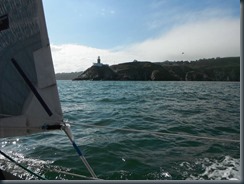
We could have stopped at Howth but had plenty of time so continued to Dun Loaghaire for a shorter trip home. Sailing across the bay we encountered several fleets of racing yachts limbering up for starts, as it was Wednesday evening. Making our way through them inside the breakwater we tied up on the pontoon at my favourite National Sailing Club. The only other yacht on the pontoon turned out to be Wanda, whose crew I knew having met in 2014! Robbie was on his own this time heading for a south coast cruise where he would meet others. Fantastic to see him again. Upstairs in the sumptuous clubhouse (despite this being the only club along the front not prefixed with ‘The Royal..’) we had drinks and dinner before heading into town and finding further refreshment at the Weatherspoons pub.
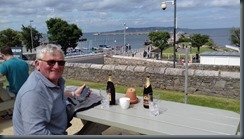
Despite the pleasant evening, future weather was not looking good, with a beat in strong wind on the menu for our home trip.
Interlude
Over breakfast at Weatherspoons we took the weather again and it looked too strong and with an unviable direction so I wasn’t happy. Howard very sensibly pointed out that it would be so much better in three days’ time, and that he and David would welcome a short break in Dublin. Sorted! As I wanted to get home for the weekend as planned, after moving the boat to the marina I hired a car, drove to Rosslare and caught the Isle of Inishmore back home for two days.
We reconvened at what had turned out to be the crew’s home from home – Weatherspoons- and planned an early start.
11-12 July Dun Loaghaire – Pembroke Dock
The wind howled worryingly all night and getting up early as planned we found it was really a deal too much and so decided to wait a couple of hours. After showers and breakfast the wind began to drop and so we nosed out of the harbour, running initially to Dalkey Sound,
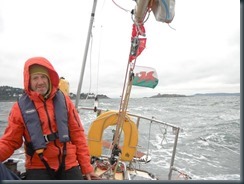
then reaching southward past West Codling, India Bank, Arklow Bank north and out to sea direct to the South Bishop. We went well, now with full main until the tide came against for its northbound turn which made the passing of the long Arklow bank with its seven giant turbines very tedious. It happens and in turn tide picked up with us and also the wind increased to force 6 which was not forecast and I checked with the coast guard who reassured me that it wasn’t forecast to rise any further. After a long session on the helm Howard went to bed and I took over sailing into the dark and through the night, passing close to the South Bishop and then on to Skomer, where I had hoped it would be light, but no. Opting for Broad Sound was nearly a mistake as we came too close and got entrained into the edge of the Wild Goose Race, and only just managed to impose our required direction with a full speed engine..phew!
Dawn broke as we gratefully approached St Ann’s and we woke Howard up to celebrate. Coming into the Haven we went through the Thorn Island passage to avoid a ship in the East Channel – not a record for the time trial Challenge I think..four weeks and three days! Motoring home we began to tidy up and get the sails away etc before pulling in at Hobbs Point where we were met by Maggie despite the early hour!
On reflection it was amazing how excepting the journey home, the whole trip went more or less to the plan I had sketched on the sofa before setting off. Many thanks to all the crew who made it possible!